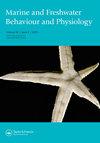角塘鹅幼鸟对繁殖群体缺水和热应激的极端水分利用
IF 1.1
4区 生物学
Q3 MARINE & FRESHWATER BIOLOGY
Marine and Freshwater Behaviour and Physiology
Pub Date : 2018-01-02
DOI:10.1080/10236244.2018.1442176
引用次数: 2
摘要
摘要塘鹅幼崽在发育过程中完全依靠鱼类猎物和代谢水来满足水分需求。由于热应力引起的蒸发冷却造成的水分损失是相当大的。为了确定塘鹅是否有节水策略,我们测量了塘鹅雏鸟和成鸟的水通量和田间代谢率(FMR)。水经济指数(WEI, g kJ−1)随着鸡龄的增加而降低,表明水分利用效率随着鸡龄的增加而增加。在羽翼发育阶段,雏鸟的WEI达到了预期的成年沙漠鸟的水平。沙漠鸟类通过较低的FMR来维持较低的WEI,而角塘鹅雏鸟的FMR与其他海鸟的雏鸟需求相当。我们认为维持低WEI对角塘鹅来说是适应性的,因为(1)雏鸟需要通过蒸发冷却来平衡水分流失,(2)雏鸟需要克服长达一周的时间,因为它们不能摄入任何水,(3)成年鸟在繁殖群体中度过较长的时间,在此期间水可能成为限制因素。随着未来气温的升高,了解维持低WEI的生理机制将变得越来越重要。本文章由计算机程序翻译,如有差异,请以英文原文为准。
Extreme water efficiency of Cape gannet Morus capensis chicks as an adaptation to water scarcity and heat stress in the breeding colony
Abstract Cape gannet Morus capensis chicks depend entirely on fish prey and metabolic water for water requirements during development. Water loss through evaporative cooling due to heat stress is substantial. We measured water flux and field metabolic rates (FMR) of Cape gannet chicks and adults to determine if gannets developed water saving strategies. The water economy index (WEI, g kJ−1) decreased with chick age according to the model WEI = 0.676 – 0.272 × log10(t), indicating that water efficiency increased with age. At fledging, the WEI of chicks was at the level expected of adult desert birds. Desert birds maintain a low WEI by also having a low FMR, whereas Cape gannet chicks have FMR comparable to other seabird species’ nestling requirements. We propose that maintaining low WEI is adaptive for Cape gannets because (1) chicks need to balance water loss through evaporative cooling, (2) fledglings need to overcome a period of up to a week when they cannot ingest any water and (3) adults spend extended periods in the breeding colony during which water can become a limiting factor. Understanding the physiological mechanism of maintaining low WEI will become increasingly important with future rising temperatures.
求助全文
通过发布文献求助,成功后即可免费获取论文全文。
去求助
来源期刊

Marine and Freshwater Behaviour and Physiology
生物-海洋与淡水生物学
CiteScore
2.10
自引率
0.00%
发文量
9
审稿时长
>12 weeks
期刊介绍:
Marine and Freshwater Behaviour and Physiology is devoted to the publication of papers covering field and laboratory research into all aspects of the behaviour and physiology of all marine and freshwater animals within the contexts of ecology, evolution and conservation.
As the living resources of the world’s oceans, rivers and lakes are attracting increasing attention as food sources for humans and for their role in global ecology, the journal will also publish the results of research in the areas of fisheries biology and technology where the behaviour and physiology described have clear links to the contexts mentioned above.
The journal will accept for publication Research Articles, Reviews, Rapid Communications and Technical Notes (see Instructions for authors for details). In addition, Editorials, Opinions and Book Reviews (invited and suggested) will also occasionally be published. Suggestions to the Editor-In-Chief for Special Issues are encouraged and will be considered on an ad hoc basis.
With the goal of supporting early career researchers, the journal particularly invites submissions from graduate students and post-doctoral researchers. In addition to recognising the time constraints and logistical limitations their research often faces, and their particular need for a prompt review process, accepted articles by such researchers will be given prominence within the journal (see Instructions for authors for details).
 求助内容:
求助内容: 应助结果提醒方式:
应助结果提醒方式:


